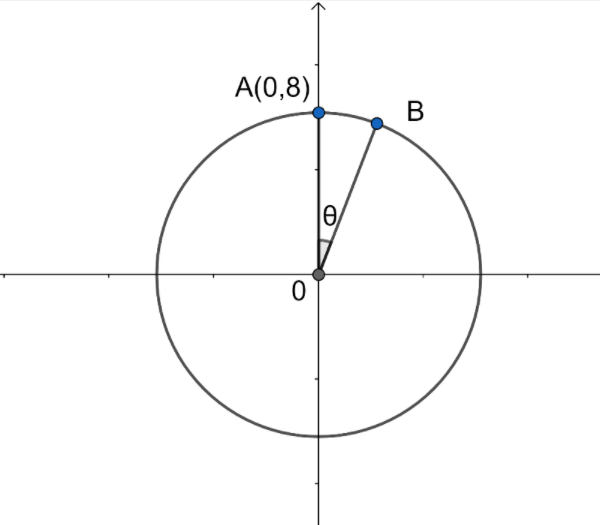
A circle centred at$\left( 0,0 \right)$ includes the point $A\left( 0,8 \right)$. Point B lies on the circle such that the angle with endpoints A and B measures 1 Radian. What is the length of $A\overset{\scriptscriptstyle\frown}{B}$.
A)$8\pi $
B)$16\pi $
C)$8$
D)$16$
Answer
512.4k+ views
Hint: To solve this question we need to have a concept of angle and circle. To solve this kind of question the first step is to find the radius of the circle. To solve the question we must know the formula for the arc of the which is $\theta r$, where $\theta $is the angle subtended by the arc in terms of radian and r is the radius of the circle.
Complete step by step solution:
The question asks us to find the length of A circle centred at $\left( 0,0 \right)$ includes the point $A\left( 0,8 \right)$. Point B lies on the circle such that the angle with endpoints A and B measures 1 Radian. What is the $A\overset{\scriptscriptstyle\frown}{B}$ length of$A\overset{\scriptscriptstyle\frown}{B}$, which means the arc $AB$.
We know that the circumference of a circle is $2\pi r$ . Here $r$ is the radius of the circle. While the area of a sector is $\theta r$ , where $\theta $ is the angle inscribed by the arc in terms of radian.
As per the question the centre of the circle is $\left( 0,0 \right)$ and a point $A\left( 0,8 \right)$is on the circle, which means the radius of the circle is $8$. The above statement can be expressed with the diagram given below:

In the question given to us the angle between the two lines $OA$ and $OB$ is $1$ Radian. Now, on substituting the radius and the angle in the formula of the arc we get:
$\Rightarrow \theta \times r$
$\Rightarrow 1\times 8$
On multiplying the two we get:
$\Rightarrow 8$
$\therefore $ The length of the arc $A\overset{\scriptscriptstyle\frown}{B}$ is option $c)$ which is $8$ for a circle centred at$\left( 0,0 \right)$ including the point $A\left( 0,8 \right)$and measuring the angle subtended by the arc $A\overset{\scriptscriptstyle\frown}{B}$ is $1$ Radian.
Note: To find the arc of a circle change the angle always in radian form as it becomes easier to find the arc of the circle. Do remember that the angle ${{360}^{\circ }}=2\pi $. These small things help a lot while solving the problem.
Complete step by step solution:
The question asks us to find the length of A circle centred at $\left( 0,0 \right)$ includes the point $A\left( 0,8 \right)$. Point B lies on the circle such that the angle with endpoints A and B measures 1 Radian. What is the $A\overset{\scriptscriptstyle\frown}{B}$ length of$A\overset{\scriptscriptstyle\frown}{B}$, which means the arc $AB$.
We know that the circumference of a circle is $2\pi r$ . Here $r$ is the radius of the circle. While the area of a sector is $\theta r$ , where $\theta $ is the angle inscribed by the arc in terms of radian.
As per the question the centre of the circle is $\left( 0,0 \right)$ and a point $A\left( 0,8 \right)$is on the circle, which means the radius of the circle is $8$. The above statement can be expressed with the diagram given below:

In the question given to us the angle between the two lines $OA$ and $OB$ is $1$ Radian. Now, on substituting the radius and the angle in the formula of the arc we get:
$\Rightarrow \theta \times r$
$\Rightarrow 1\times 8$
On multiplying the two we get:
$\Rightarrow 8$
$\therefore $ The length of the arc $A\overset{\scriptscriptstyle\frown}{B}$ is option $c)$ which is $8$ for a circle centred at$\left( 0,0 \right)$ including the point $A\left( 0,8 \right)$and measuring the angle subtended by the arc $A\overset{\scriptscriptstyle\frown}{B}$ is $1$ Radian.
Note: To find the arc of a circle change the angle always in radian form as it becomes easier to find the arc of the circle. Do remember that the angle ${{360}^{\circ }}=2\pi $. These small things help a lot while solving the problem.
Recently Updated Pages
Two men on either side of the cliff 90m height observe class 10 maths CBSE

What happens to glucose which enters nephron along class 10 biology CBSE

Cutting of the Chinese melon means A The business and class 10 social science CBSE

Write a dialogue with at least ten utterances between class 10 english CBSE

Show an aquatic food chain using the following organisms class 10 biology CBSE

A circle is inscribed in an equilateral triangle and class 10 maths CBSE

Trending doubts
Why is there a time difference of about 5 hours between class 10 social science CBSE

Write a letter to the principal requesting him to grant class 10 english CBSE

What is the median of the first 10 natural numbers class 10 maths CBSE

The Equation xxx + 2 is Satisfied when x is Equal to Class 10 Maths

Which of the following does not have a fundamental class 10 physics CBSE

State and prove converse of BPT Basic Proportionality class 10 maths CBSE




